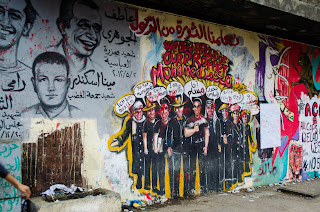I really enjoyed this week's readings because I find it so interesting to learn about the ways in which societies express themselves in times of war or conflict, whether this is through art, music, or other such mediums. It is such a cool idea to look at graffiti specifically as a tool for political expression and/or resistance, especially in the Middle East where I think this is so much more common due to perhaps laxer laws against graffiti, and also because of the huge amount of current political issues happening in the region.
When I think back to my semester in Cairo, I immediately think of the huge amount of graffiti literally almost everywhere you go in the city. It is without question a political tool that was and still is being used here: people were using public spaces to express their views against the Mubarak and (afterwards) the Morsi regime. Egyptians put so much effort into this public artwork that many of them were amazing to look at. One image I have in my mind was a huge tank painted under a bridge with an Egyptian soldier sticking out, while in front of the tank (above to get run over) was a man kneeling and praying (in the form typical for Islam). There are also sprayed images of young men who I'm assuming were killed in the Egyptian Revolution and maybe even afterwards (they are considered martyrs).
Here are examples of some extremely detailed and complex Egyptian graffiti in Tahrir Square during the recent protests. (One of my friends took them; as a woman, I wasn't safe to go downtown during these protests).
I find it so interesting that in these types of countries going through such huge transitions, political protest manifesting itself through graffiti is so expected that it is not even punished (or if so, it;'s very rare). I don't know if this would be possible to do in a large city like New York or Chicago without police intervention.
When I think back to my semester in Cairo, I immediately think of the huge amount of graffiti literally almost everywhere you go in the city. It is without question a political tool that was and still is being used here: people were using public spaces to express their views against the Mubarak and (afterwards) the Morsi regime. Egyptians put so much effort into this public artwork that many of them were amazing to look at. One image I have in my mind was a huge tank painted under a bridge with an Egyptian soldier sticking out, while in front of the tank (above to get run over) was a man kneeling and praying (in the form typical for Islam). There are also sprayed images of young men who I'm assuming were killed in the Egyptian Revolution and maybe even afterwards (they are considered martyrs).
Here are examples of some extremely detailed and complex Egyptian graffiti in Tahrir Square during the recent protests. (One of my friends took them; as a woman, I wasn't safe to go downtown during these protests).
I find it so interesting that in these types of countries going through such huge transitions, political protest manifesting itself through graffiti is so expected that it is not even punished (or if so, it;'s very rare). I don't know if this would be possible to do in a large city like New York or Chicago without police intervention.












